Starter (For 1.7 Kw Type) -- Inspection |
| 1. INSPECT STARTER ASSEMBLY |
- CAUTION:
- As a large electric current passes through the cable during this inspection, a thick cable must be used. Otherwise, the cable may become hot and cause injury.
- NOTICE:
- The following tests must each be performed within 3 to 5 seconds to prevent the coil from burning out.
Mount the starter in a vise between aluminum plates.
Perform a pull-in test.
Remove the nut, and then disconnect the lead wire from terminal C.
Connect the battery to the magnet starter switch as shown in the illustration. Then check that the clutch pinion gear moves outward.
If the clutch pinion gear does not move, replace the magnet starter switch assembly.Text in Illustration *1 Terminal 50 *2 Terminal C 
Moves outward
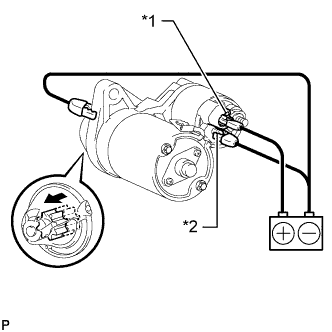
Perform a holding test.
Disconnect the negative (-) terminal lead from terminal C with the condition specified in the pull-in test above being maintained. Check that the pinion gear remains out.
If the clutch pinion gear returns inward, replace the magnet starter switch assembly.Text in Illustration *1 Terminal C 
Disconnect
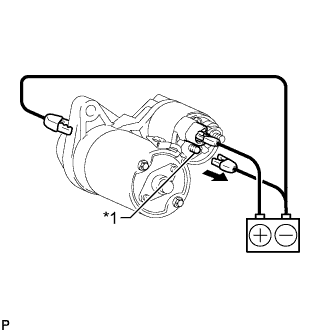
Inspect the clutch pinion gear return.
Disconnect the negative (-) lead from the starter body. Check that the clutch pinion gear returns inward.
If the clutch pinion gear does not return inward, replace the magnet starter switch assembly.Text in Illustration 
Disconnect 
Returns inward

Perform an operation test without load.
Connect the lead wire to terminal C.
- Torque:
- 8.0 N*m{82 kgf*cm, 71 in.*lbf}
Connect the battery and an ammeter to the starter as shown in the illustration.
Text in Illustration *1 Terminal 30 *2 Terminal 50 Check that the starter rotates smoothly and steadily while the pinion gear is moving outward. Then measure the current.
- Standard current:
- 90 A or less at 10.9 V
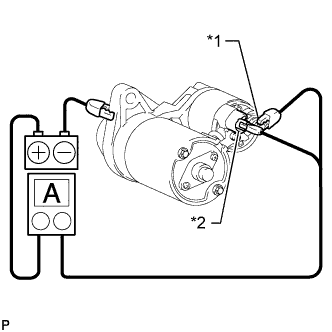
| 2. INSPECT STARTER ARMATURE ASSEMBLY |
Check the commutator for dirt and/or burns on the surface.
If the surface is dirty or burnt, correct it with sandpaper (No. 400) or a lathe.
If necessary, replace the starter armature assembly.
Inspect the commutator for an open circuit.
Measure the resistance according to the value(s) in the table below.
- Standard Resistance:
Tester Connector Condition Specified Condition Segment - Segment Always 3.0 to 3.3 Ω
If the result is not as specified, replace the starter armature assembly.Text in Illustration *1 Segment
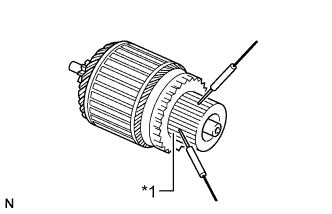
Inspect the commutator for short circuit.
Measure the resistance according to the value(s) in the table below.
- Standard Resistance:
Tester Connector Condition Specified Condition Segment - Coil Core Always 10 kΩ or higher
If the result is not as specified, replace the starter armature assembly.Text in Illustration *1 Segment *2 Coil Core

Check the commutator circle runout.
Place the commutator on V-blocks.
Using a dial indicator, measure the circle runout.
- Standard circle runout:
- 0.02 mm (0.000787 in.)
- Maximum circle runout:
- 0.04 mm (0.00157 in.)
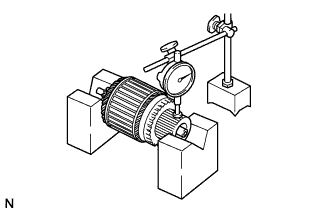 |
Check the commutator diameter.
Using a vernier caliper, measure the commutator diameter.
- Standard diameter:
- 32.2 mm (1.27 in.)
- Minimum diameter:
- 31.1 mm (1.22 in.)
If the diameter is less than the minimum, replace the starter armature assembly.Text in Illustration *1 Diameter

Check the undercut depth.
Using a vernier caliper, measure the undercut depth of the commutator.
- Standard depth:
- 0.9 mm (0.0354 in.)
- Minimum depth:
- 0.4 mm (0.0157 in.)

| 3. INSPECT STARTER BRUSH HOLDER ASSEMBLY |
Check the brush length.
Using a vernier caliper, measure the brush length.
- Standard length:
- 11.3 mm (0.445 in.)
- Minimum length:
- 7.5 mm (0.295 in.)
If the length is less than the minimum, replace the starter brush holder assembly.Text in Illustration *1 Length
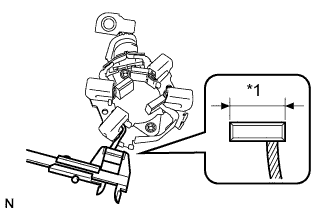
Inspect the brush insulation.
Measure the resistance according to the value(s) in the table below.
- Standard Resistance:
Tester Connection Condition Specified Condition A - B
A - C
B - D
C - DAlways 10 kΩ or higher A - D
B - CBelow 1 Ω
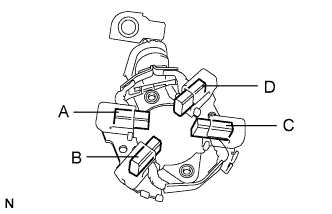
| 4. INSPECT STARTER CLUTCH SUB-ASSEMBLY |
Rotate the clutch pinion gear clockwise and check that it turns freely. Try to rotate the clutch pinion gear counterclockwise and check that it locks.
If the result is not as specified, replace the starter clutch sub-assembly.Text in Illustration 
Free 
Lock
 |
| 5. INSPECT MAGNET STARTER SWITCH ASSEMBLY |
Check the plunger.
Install the plunger and spring to the switch body.
Text in Illustration *1 Switch Body *2 Spring *3 Plunger Push in the plunger and check that it returns quickly to its original position.
If the result is not as specified, replace the magnet starter switch assembly.

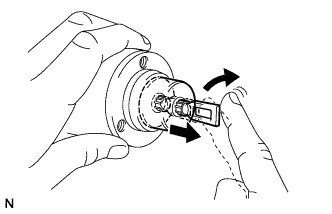
Check the resistance.
Measure the resistance according to the value(s) in the table below.
- Standard Resistance:
Tester Connection Condition Specified Condition Terminal 50 - Terminal C Always Below 1 Ω
If the result is not as specified, replace the magnet starter switch assembly.Text in Illustration *1 Terminal 50 *2 Terminal C
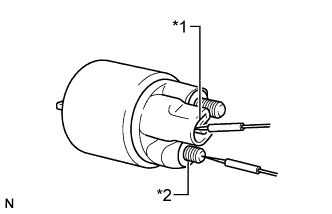 |
Measure the resistance according to the value(s) in the table below.
Measure the resistance according to the value(s) in the table below.
- Standard Resistance:
Tester Connection Condition Specified Condition Terminal 50 - Switch body Always Below 2 Ω
If the result is not as specified, replace the magnet starter switch assembly.Text in Illustration *1 Terminal 50 *2 Switch Body
 |